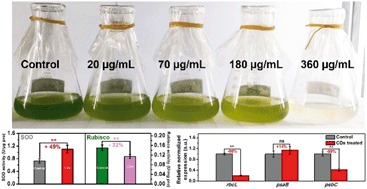Biotoxicity of degradable carbon dots towards microalgae Chlorella vulgaris†
Abstract
Carbon-based nanomaterials (CNMs) have been widely applied to various fields, such as catalysis, sensing and biomedicine. The understanding of the toxicological impacts of CNMs could better help us to make use of these materials. Carbon dots (CDs), a new member of the carbon nanomaterials' family, have become a hot topic in scientific research due to their excellent water solubility, easy modification and unique optical properties. Herein, degradable CDs, which could be degraded under visible light, were synthesized by a one-step electrolytic method. These CDs have further demonstrated their toxic effects on Chlorella vulgaris. The algae growth, oxidative stress, cell morphology and photosynthetic activity were assessed for evaluating the toxicology of the obtained CDs. Results showed that the CDs were detrimental to the growth of Chlorella vulgaris and the EC50 for the growth of Chlorella vulgaris after 4 days was 70 μg mL−1 based on the growth rate. The CDs can cause oxidative stress by producing amounts of ROS and increasing the activities of SOD by 49%. Furthermore, CDs can disrupt the photosynthetic system of Chlorella vulgaris. They changed the cells' photosynthetic pigment content, decreased the Rubisco activity (−32%) and inhibited the transcription of photosynthesis-related genes.



 Please wait while we load your content...
Please wait while we load your content...